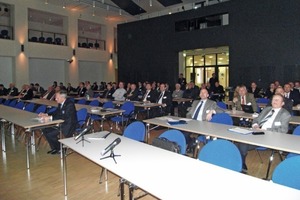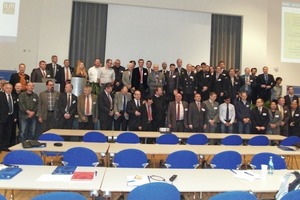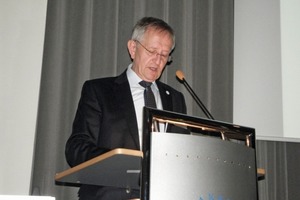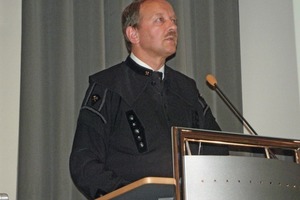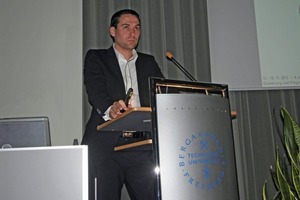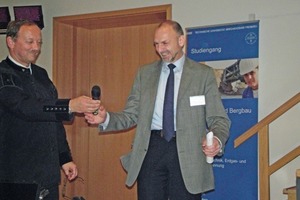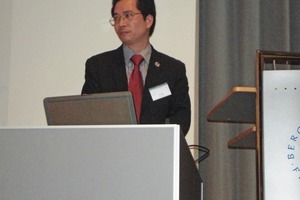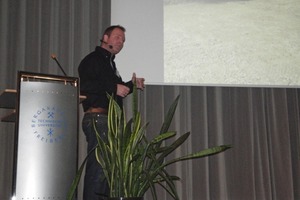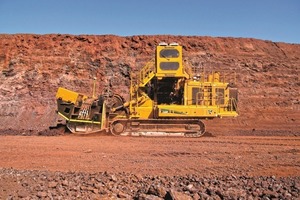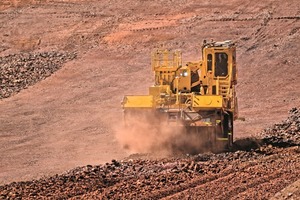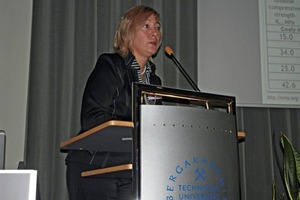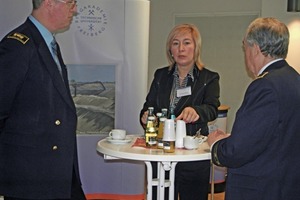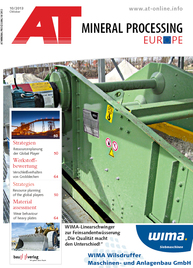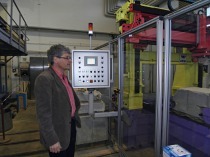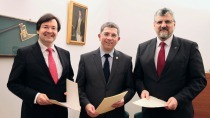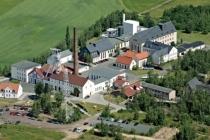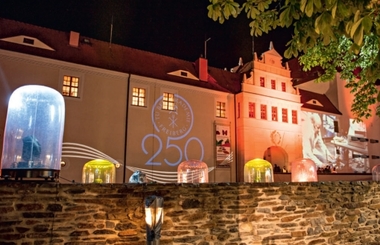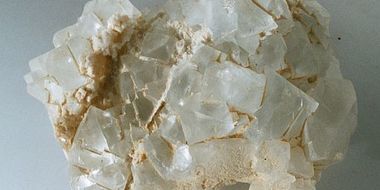Mining is alive!
4th International Colloquium on Non-Blasting Rock ExtractionAround 130 highly specialized professionals followed the invitation of the Institute of Mining at TU Bergakademie Freiberg to the 4th International Colloquium on “Non-Blasting Rock Extraction” held in Freiberg, Saxony, from 14. – 17.11.2012 (Fig. 1). This is a specialist forum for mining, specialized civil engineering and tunnelling as well as for the construction industry. Organizer of the conference, which is held every four years, is the “International University of Resources” founded in 2007, of which TU Bergakademie Freiberg is a founding member. Integrated in this colloquium was the 4th International Protodjakonov-Colloquium, which has been held in Dnepropetrovsk alternately in Ukraine and Freiberg every two years since 2008. The Russian mining engineer Protodjakonov (1874 – 1930) is regarded as the founder of one of the practical classifications of rock that is still used today.
Scientists from 15 European universities (besides Germany, Bulgaria, Italy, Romania, Russia, Serbia and Ukraine), but also from China, Vietnam and Thailand as well as representatives from companies took the opportunity for interdisciplinary transfer of information in the field of geomechanics, extraction by cutting, drilling technology and mineral processing (Fig. 2). Resource efficiency was a key issue at this colloquium too, here with regard to resource-efficient extraction of raw materials. The speakers presented new methods for fully mechanical rock extraction and the test findings that had been obtained. Goal of all efforts is optimization in respect of extraction and conveying rates, dust generation and tool wear.
In his welcoming speech, his Magnificence Prof. Dr.-Ing. Bernd Meyer (Fig. 3), Rector of TU Bergakademie Freiberg, emphasized that the colloquium addresses a very special and important aspect of mining and the transfer of scientific and practical solutions is more important than ever. He explained “Mining can only be successful in future if consideration is given to the needs of resource conservation and environmental protection. And so the material and energy efficiency will also be a key topic at the first global forum of the universities on 30.10.2013 in St Petersburg/Russia, which will mark the founding of the mining university there 240 years ago.” The global forum for sustainability of the resource universities was founded in Freiberg in June 2012; already 80 universities belong to it. The purpose of this forum is to anchor higher standards committed to sustainable development in the education and training of mining engineers.
In his opening lecture, Prof. Prof. e. h. Dr. Dr. h. c. mult. Carsten Drebenstedt (Fig. 4), Director of the Institute of Mining at TU Bergakademie Freiberg, began with an overview of mining in Germany, which, contrary to widely held opinion, is still an important branch of industry today. After all, in the last report on worldwide mining data, Germany ranks in 12th place. Main mining products are lignite, coal, potassium salt, lime and alumina. Germany also has a long tradition in the development and engineering of the necessary mining technology. Prof. Drebenstedt took the opportunity to present his Institute and the possibilities for graduating in a mining discipline at TU Bergakademie Freiberg. In addition, he presented various research projects focussing on resource planning, modelling of surface mining, and visualization of the extraction process. While “fully mechanical extraction processes may be highly efficient and achieve high extraction and conveying rates, owing to the constant contact of the tool with the rock a great deal of dust and an unwanted high fines percentage is produced.” For this reason, research on optimization is imperative.
With the “Optimization of the cutting process and forecast of the relevant working parameters in rock destruction with consideration of chisel bit wear” was the subject addressed by Dr.-Ing. Maxim Vorona (Fig. 5), Montan Bildungs- und Entwicklungsgesellschaft, Zeitz. To this end, he investigated the influence of cutting resistance, contact and side force on the cutting characteristics such as cutting depth, specific energy consumption, fragmented size of the material and dust generation.
Dr Stefan Strunk, RWE Power AG, Essen, spoke on the special characteristics of the Hambach lignite deposit (NRW), at which clay ironstone (siderite deposit/FeCO3 embedded in hard clay bands) makes extraction of the coal difficult (Fig. 6). The areas with clay ironstone cause considerable problems during extraction and conveying: high excavation forces are required to loosen the rock, generating strong vibrations and the sharp-edged blocks of stone quickly lead to destruction of the belts such that machine performance is often only 40 % of the normal capacity. The speaker outlined potential solutions for these problems, for which an analysis of the destruction of the clay ironstone bands must first be conducted. A large number of machine and technological modifications, e.g. the development of completely new buckets for the bucket wheel excavator or the use of rubber-cushioned elements and steel plates for the belt conveyors and the development of repair strips enabling quick fixes, have been made. Although only small improvements in performance have been achieved in respect of coal winning and the extraction of clay ironstone, the downtime of the conveying belts, however, has been reduced considerably.
Prof. Viktor Atrushkevich, Moscow State Mining University, Russia, reported on the “Development of non-blasting technologies for ore and coal extraction“ and emphasized that extraction technologies are multifaceted processes that require close interlinking of technical and organizational solutions. With the goal of improving the efficiency of underground coal mining in the Kuzbass region of Siberia, a mechanical/hydraulic energy-saving method was developed, which the speaker presented.
Dipl.-Ing. Ulf Kirsten reported on fundamental investigations in his paper headed “Experimental investigations on impact-based rock destruction for description of drilling in hard rock” to obtain basic information regarding fracture mechanical behaviour on external loading and the energy necessary for rock destruction. For this purpose, drop impact tests were performed on different sample rocks (quartzite, rhyolite and gabbro) and the structure and properties of the rocks, the penetration behaviour, crater volume, the specific energy and the particle size distributions were determined. As a result, important findings were obtained concerning the working conditions of cutting materials in the new field of application in deep geothermal energy. Images captured with a high-speed camera showed the destruction mechanisms in atmospheric conditions. In addition, dynamic effects and the effect of impact velocity on the destruction process were studied. The work is to be continued with other rocks, including rocks of sedimentary origin, with variation of the geometry and the material of the impact elements.
A well-structured overview of technological process and technical equipment for rock extraction in the mining industry was given by Dipl.-Ing. Christoph Kuchinke, RWTH University of Aachen. He went into the most important factors influencing the development of mining machines, like, for example, the location of the extraction site, the extraction method, the type of rock or the power transmission. Besides blasting methods, these are primarily the mechanical processes like cutting, slabbing, jarring as well as non-mechanical methods such as flame cutting and the use of non-mechanical “tools” (temperature, water jet drilling, ultrasound) as well as thermoelectrical or chemical methods. By studying all known energy sources and machines, the speaker succeeded in classifying the technologies.
The design of the tools as an important variable for effect mechanical rock extraction was the subject of two other papers: Dipl.-Ing. Andreas Keller, TU Bergakademie Freiberg: “Effects of tool activation” and B. Grosso, Università degli Studi di Cagliari/Italy: “The problem of water jet effect on the mechanical tools in the extraction of medium to hard rock”.
Dr.-Ing. X. Bui (Bild 7), University of Hanoi/Vietnam, spoke on the extraction of titanium soaps in Vietnam and presented both opportunities and challenges. While in the past, the raw material used to be exported from Vietnam, research has been started there to achieve greater processing depth within the country and bring higher grade concentrates to the market. The goal is sustainable titanium extraction. Besides research, a master plan must be drawn up for the exploration, extraction and processing. Moreover, government management of licensing and ore consumption must be improved.
On the second day of the conference, mainly foreign authors took the floor, like, for example, Paul van Helden (Fig. 8), Vermeer EMEA AV’s-Heer Arendskerke/Netherlands, who presented “Latest advances in surface extraction technology” in an impressive overview. For more than 10 years Vermeer has supplied a wide range of mining technology and exports surface mining equipment to over 100 countries. With machines in the Terrain Leveller series, thanks to the use of lasers and GPS, working and comminution accurate to a centimetre down to around ≤ 300 mm are possible without blasting and drilling. Various machines were shown, for example the T1655 TL terrain leveller, which was developed primarily for vast deposits such as in Australia (iron ore). With a roller width of 4.5 m and a drive power of 894.8 kW, this has a maximum cutting depth of 71 cm (Fig. 9 and Fig. 10).
Prof. D. Ignjatovic, University of Belgrade/Serbia, spoke on the “Effect of the optimization of the cutting elements on the efficiency of bucket wheel excavators”, a key topic for coal mining in Serbia, as the reserves in the surface mines there still amount to more than 4 bill. tonnes. Various influencing variables were studied, e.g. the design of excavator and, based on modelling of the shovel structure, the design was optimized. The author described the procedure as a good example of industrial research in Serbia.
An overview of the research in the last 13 years on blasting-free extraction of rocks and coal in surface and deep mining at the Petrosani University of Technology in Romania, Department of Mining Technology, was given by Dr I. Kovacz. From scientific studies on laboratory scale on test machines, cutting tools, but also new gearwheels for bucket wheel excavators and an asymmetric bucket were developed. New surface mining technology at the Chalkovskij-2 mine was explained by Prof. A. Cherep from the State Mining University of Dnepropetrovsk (Ukraine) and Dr.-Ing. Doral Gusant, North University of Baia Mare/Romania spoke on “Continuous conveyors at the Ocna Dej salt deposit – a new description of the extraction technology”. At Ocna Dej the third level, at a depth of more than 100 m, will be reached in 2015. Extraction is still performed by means of drilling and blasting, but with a yield of 400 000 t/a, there is great interest in non-blasting technology.
An only occasionally addressed but no less important topic was discussed by Dr.-Ing. habil. S. W. Kalchuk, State University of Zhytomir, Ukraine: “Studies on crack propagation in the extraction of architectural building blocks with the application of non-blasting methods”. These blocks must of course be cut very carefully. From the around 300 quarries with appropriate material, only 164 have so far been exploited. Dr Kalchuk presented different extraction technologies, based on results of the crack formation processes, and showed that the hydraulic wedge methods are most favourable.
A similar problem was addressed by Prof. J. Agafonov, Moscow State Mining University, Russia, in his paper “Technology of the extraction of natural stone in limestone deposits with a complex structure”. As the use of explosives in the many open lime quarries around Moscow with complicated structure leads to unprofitable extraction and poor stone quality, non-blasting extraction is highly topical. The special characteristics of these deposits should be taken into consideration. Mechanical shovels, hydraulic excavators, and selective cut heading machines with boom and stripper machines have been tested.
Finally, in her talk “Securing rock stability during the removal of face equipment”, Olena Sdvyzhkova (Fig. 11), Dnepropetrovsk State University of Mining (Ukraine) discussed digital simulation of the load on the rock mass. The calculations were performed for four arched and rectangular chambers. The conclusion: the experience gained with the chambers was positive, the arched chambers not being very comfortable but effective.
The event was concluded with an excursion to the teaching and research mine “Himmelfahrt-Fundgrube” and inspection of the test rig for cutting extraction at the Institute of Mining, about which a separate report will be published in another issue.
In his closing words, Prof. Drebenstedt commented that the conference was a good mix of research, development and practical application. The experts were able to exchange views on the findings presented (Fig. 12). The papers had clearly shown that the individual processes of rock extraction must be regarded as a whole and the different processes are all justified depending on their various applications. Issues of safety, health and environmental protection should not be left out of consideration. “It is our responsibility to include all these aspects in our technologies. Negative mining consequences should not be allowed to happen!” says Prof. Drebenstedt. The papers presented at the conference at TU Bergakademie Freiberg will be published in a volume of proceedings.
The next conference on “Non-blasting rock extraction” will be held in Freiberg in 2016. Marking the celebrations for the 250th anniversary of the founding of Freiberg Academy of Mining in 2015, a big mining conference will be organized.
Author: Dr. Brigitte Hoffmann, Consulting office for waste and environmental protection, Oberschöna/Germany

